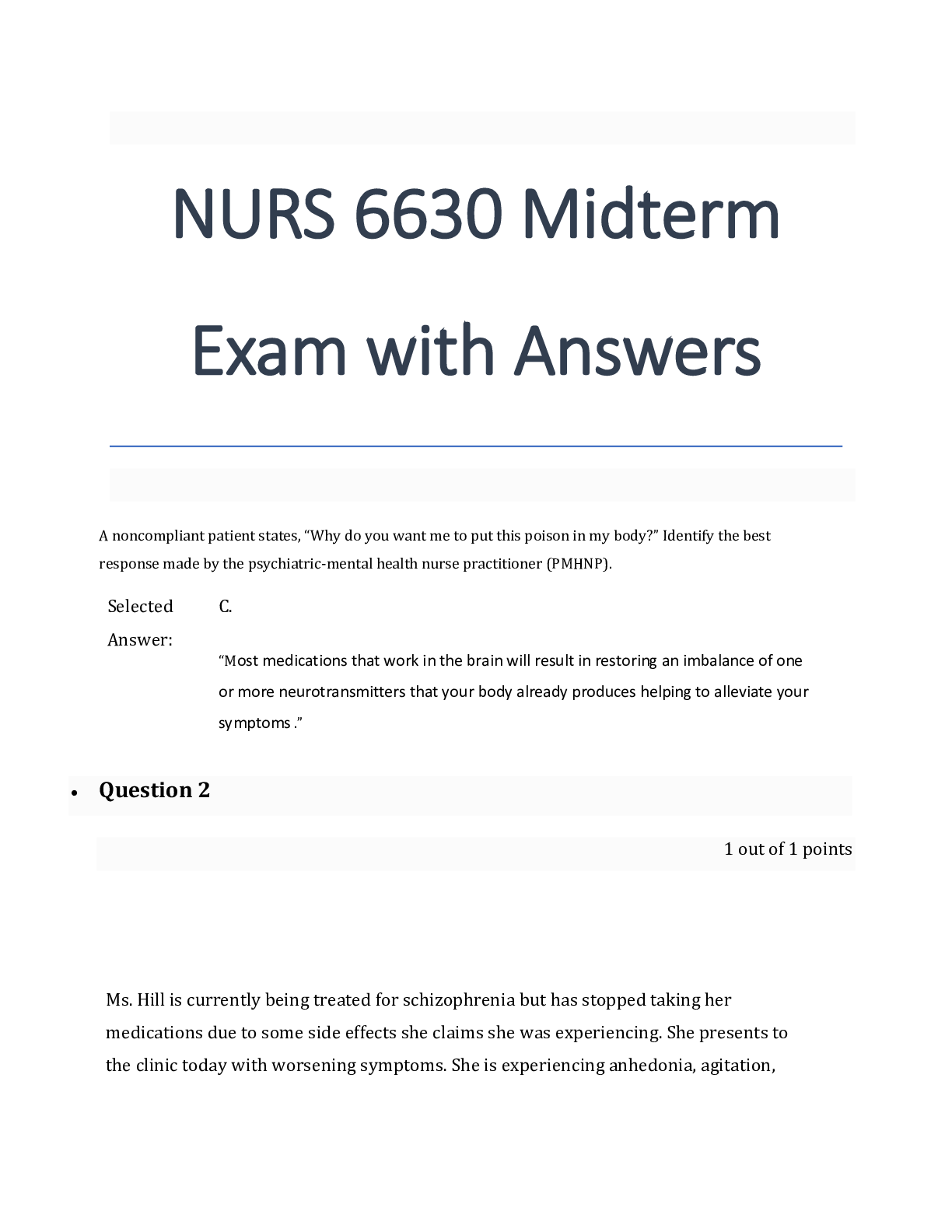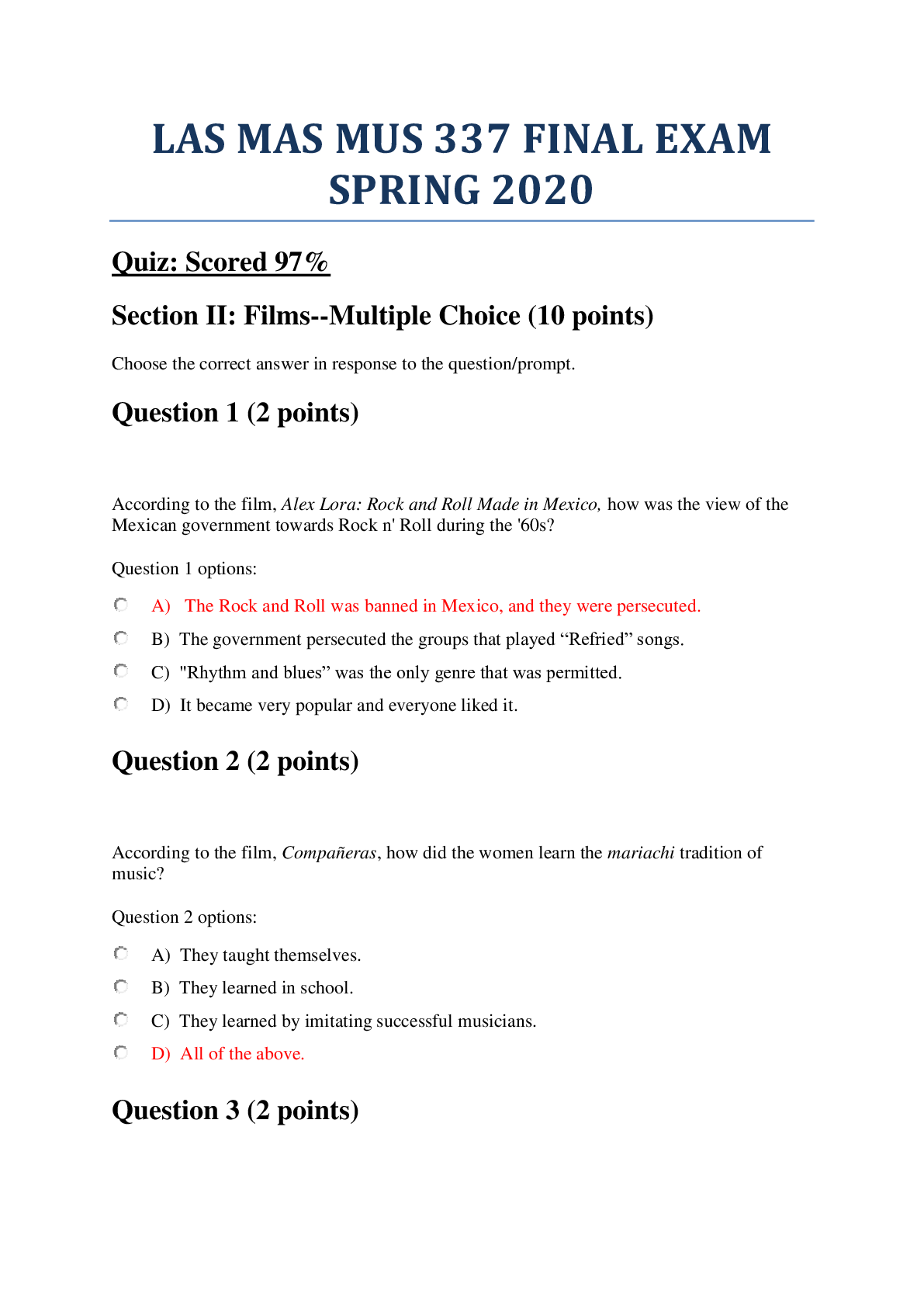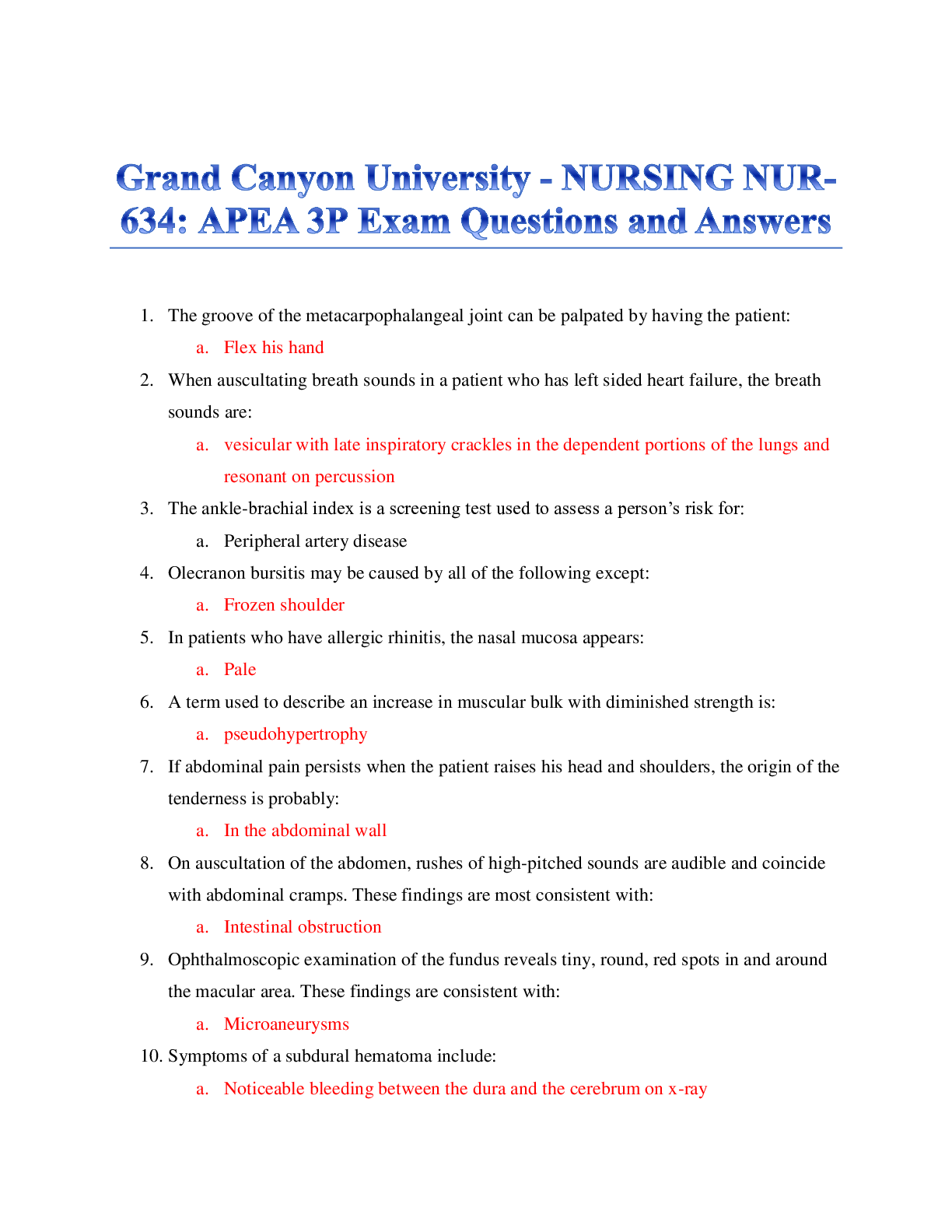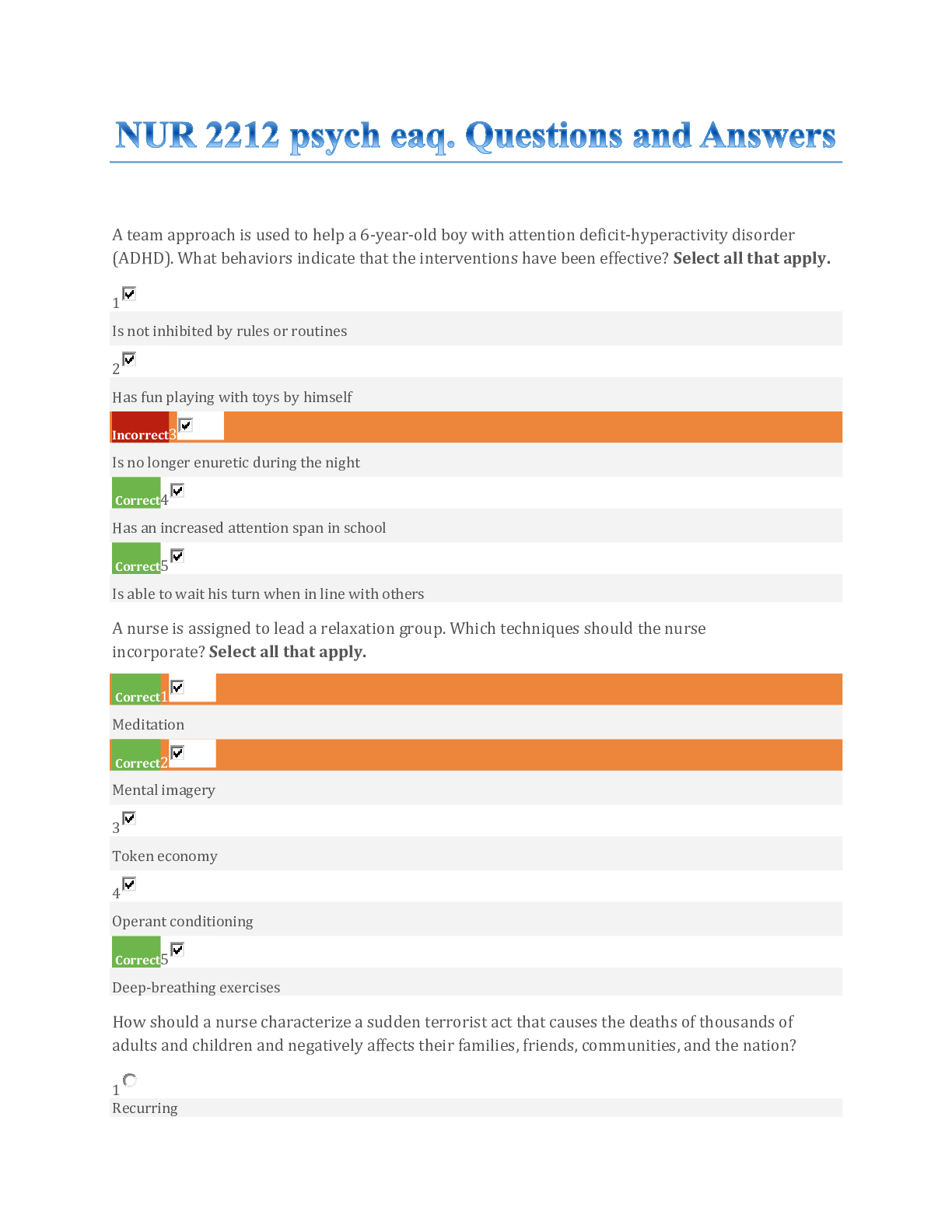Walden University - PHARM NURS6521Week 3 quiz. 100%
Document Content and Description Below
PHARM NURS6521Week 3 quiz • Question 1 1 out of 1 points A patient with class-IV CHF has a medication regimen consisting of metoprolol (Lopressor), enalapril (Vasotec), and furosemide (Lasix)... . In addition to regularly assessing the patient s heart rate, the nurse should prioritize assessment of the patient's • Question 2 0 out of 1 points A nurse is caring for a patient who is taking digoxin and a loop diuretic. Which of the following would be most important for the nurse to monitor? • Question 3 1 out of 1 points Which of the following patients is most likely to benefit from the administration of an adrenergic agonist? • Question 4 1 out of 1 points A patient is admitted to the emergency department with severe chest pain. The emergency department physician orders intravenous nitroglycerin 5 mcg/min, titrate dose by 5 mcg/min every 3 to 5 minutes per infusion pump as needed. Before administering the nitroglycerin, the nurse should prioritize which of the following assessments? • Question 5 1 out of 1 points A 62-year-old man has been prescribed extended-release lovastatin. The nurse will instruct the patient to take the medication • Question 6 1 out of 1 points A patient is diagnosed with heart failure and is started on digoxin. On the second day of therapy, lab values, the ECG results, and the patient's symptoms indicate that the medication is not producing a therapeutic effect. An appropriate nursing action would be to • Question 7 1 out of 1 points A nurse is the cardiac care unit is preparing to hang an intravenous dose of dofetilide (Tikosyn) for a patient who has just been admitted. What is the most likely goal of this intervention? • Question 8 1 out of 1 points A normal maintenance dose for digoxin is 0.125 to 0.5 mg/day. In which of the following patients would the nurse most likely administer a lower-than-normal maintenance dose of digoxin? • Question 9 0 out of 1 points A nurse is caring for a male patient who has a diagnosis of coronary artery disease (CAD). His drug therapy includes lovastatin. Because the patient has a history of severe renal disease, the nurse will assess for which of the following? • Question 10 1 out of 1 points A 77-year-old man's chronic heart failure is being treated with a regimen of quinapril (Accupril) and furosemide (Lasix). Which of the following assessment findings would suggest that the loop diuretic is contributing to a therapeutic effect? • Question 11 1 out of 1 points A nurse who provides care in a busy clinic is aware of the high incidence and prevalence of hyperlipidemia and the consequent need for antihyperlipidemics in many patients. Treatment of high cholesterol using statins would be contraindicated in which of the following patients? • Question 12 1 out of 1 points A resident of a long-term care facility receives 12.5 mg metoprolol (Lopressor) at 8 AM and 8 PM daily. Before administering this drug, the nurse should perform and document what assessments? • Question 13 1 out of 1 points A 55-year-old man's hypertension has not responded adequately to his current medication regimen consisting or an ACE inhibitor, a beta-blocker and a thiazide diuretic. As a result, he will soon begin taking hydralazine (Apresoline) in addition to his existing antihypertensives. The addition of this medication to his regimen means that the nurse must prioritize which of the following nursing actions? • Question 14 1 out of 1 points A priority nursing assessment for a patient who is to receive an alpha- or beta-adrenergic antagonist would be to • Question 15 1 out of 1 points A patient has been prescribed lovastatin for a high cholesterol level. The nurse's teaching plan will include a basic explanation of how the drug produces its therapeutic effect. The nurse will explain that lovastatin lowers cholesterol levels because it • Question 16 1 out of 1 points A nurse is providing patient education to a 35-year-old man who has been prescribed clonidine (Catapres) as part of step 2 antihypertensive therapy. The nurse should anticipate that the drug will be administered • Question 17 1 out of 1 points A nurse is caring for a patient who is admitted into the cardiac care unit with acute, decompensated heart failure. Nesiritide (Natrecor) has been ordered. When preparing for administration of the drug, the nurse will • Question 18 1 out of 1 points A patient is brought to the emergency department in hypertensive crisis. Nitroprusside is administered intravenously. The patient experiences diaphoresis and dizziness. Which of the following is the appropriate action by the nurse? • Question 19 1 out of 1 points A 70-year-old woman with a history of atrial fibrillation takes digoxin and verapamil to control her health problem. Verapamil achieves a therapeutic effect by • Question 20 1 out of 1 points A 62-year-old man is admitted to the hospital with a diagnosis of chest pain. He has an order for 0.3 mg of sublingual nitroglycerin prn for chest pain. Which of the following actions should the nurse do first when he complains of chest pain? • Question 21 1 out of 1 points A nurse explains to a patient that nitroglycerin patches should be applied in the morning and removed in the evening. This medication schedule reduces the potential for • Question 22 1 out of 1 points Several months of treatment with a statin accompanied by lifestyle modifications have failed to appreciably improve a patient's cholesterol levels. Consequently, the patient has been prescribed cholestyramine. The nurse should recognize that this drugs achieves its therapeutic effect by • Question 23 1 out of 1 points A nurse is caring for a patient who is diabetic and has been diagnosed with hypertension. An angiotensin-converting enzyme inhibitor, captopril, has been prescribed for her. Which of the following should the nurse assess before beginning drug therapy? • Question 24 1 out of 1 points A 58-year-old man is admitted to the emergency department. A diagnosis of severe digoxin toxicity is made. Bradycardia is present, and an electrocardiogram (ECG) confirms toxicity. The nurse will administer which of the following drugs? • Question 25 1 out of 1 points A nurse is caring for a patient with chronic angina. The patient is receiving ranolazine (Ranexa) 500 mg PO bid. Which of the following signs or symptoms would the nurse attribute to being a common adverse effect of this medication? [Show More]
Last updated: 2 years ago
Preview 1 out of 10 pages
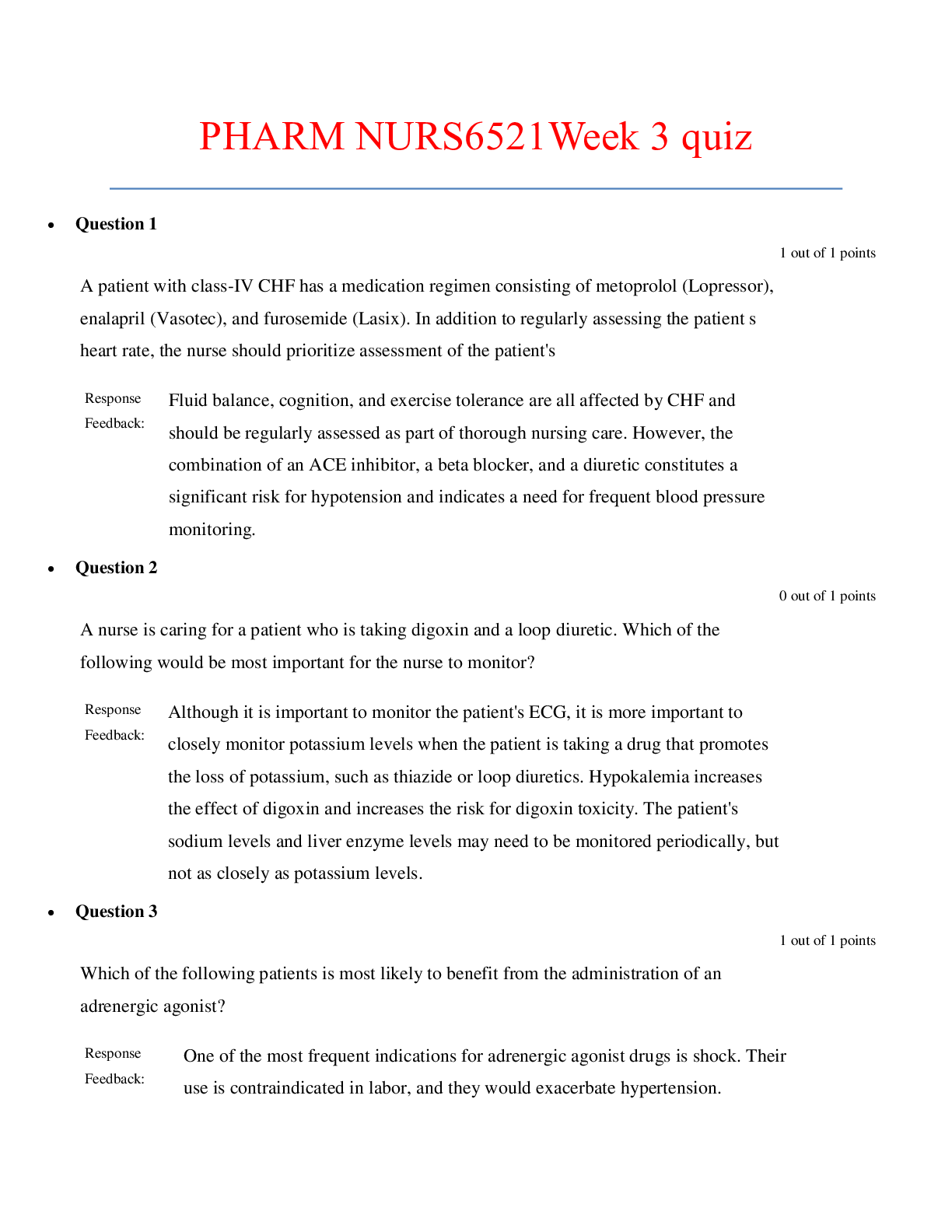
Buy this document to get the full access instantly
Instant Download Access after purchase
Buy NowInstant download
We Accept:

Reviews( 0 )
$9.00
Can't find what you want? Try our AI powered Search
Document information
Connected school, study & course
About the document
Uploaded On
Jul 12, 2020
Number of pages
10
Written in
Additional information
This document has been written for:
Uploaded
Jul 12, 2020
Downloads
0
Views
106

